#Hossein Rezai
Text
THROUGH THE OLIVE TREES:
In meta drama
Tea man tries to court actress
While acting in scene
youtube
#through the olive trees#random richards#poem#haiku#poetry#haiku poem#poets on tumblr#haiku poetry#haiku form#poetic#criterion collection#abbas kiarostami#Hossein Rezai#Koker trilogy#Youtube
1 note
·
View note
Text
TURISIAN.com - Konsep Bandara Banyuwangi tuh keren abis nih, guys! Mereka baru aja dapet penghargaan banget, loh, yakni Aga Khan Award for Architecture bulan November 2022 kemarin.
Makanya, Direktur Aga Khan Award, Farrokh Derakhshani, dateng langsung ke Bandara Banyuwangi buat ngunjungin dan mengapresiasi desainnya yang keren itu.
Dan, kebetulan juga lagi ada Festival Arsitektur Nusantara di Banyuwangi pas tanggal 22-24 Juni 2023.
Jadi, pas Farrokh nyampe di Bandara Banyuwangi hari Jumat, tanggal 23 Juni 2023, dia ngaku kagum banget sama desain terminal bandaranya yang ramah lingkungan.
BACA JUGA: Tetap Buka di Bulan Ramadhan, Ini Cara Beli Tiket Masuk ke Banyuwangi Park
Dia bilang, "Sistem udara di dalam Bandara Banyuwangi bener-bener sejuk, guys! Tadi pas turun dari pesawat, langsung berasa udara tropisnya. Tapi begitu masuk ke terminal bandara, langsung adem gitu rasanya,"
Emang sih, Bandara Banyuwangi ini dibangun dengan konsep hijau dan ramah lingkungan. Mereka nggak ikutan tren bandara internasional pada umumnya, loh.
Mereka bangun bandaranya dengan memanfaatkan sumber daya lokal, teknologi yang tepat, dan desain yang memperhatikan lingkungan sekitar.
Mereka juga ngatasi iklim panas di Indonesia dengan cara yang keren, guys. Mereka bikin infrastruktur yang memanfaatkan ventilasi alami, kayak bukaan dan overhang gitu.
BACA JUGA: Cara Banyuwangi Membangkitkan Sektor Pariwisata yang Sempat Terpuruk
Kearifan Lokal
Jadi udara di dalam bandara tetep sejuk tanpa harus tergantung sama AC terus. Kayaknya tuh bener-bener ngerti banget cara ngatur aliran udara, karena ada pohon-pohon rindang yang bikin suasana jadi alami banget.
Nggak cuma itu, fasad bangunan Bandara Banyuwangi juga keren banget, guys! Mereka ngambil inspirasi dari kearifan lokal Kabupaten Banyuwangi, loh.
Jadi, bentuk fasadnya mirip Udeng, penutup kepala khas Suku Osing yang tinggal di sana.
Btw, menurut Farrokh, konsep pembangunan Bandara Banyuwangi ini ada kesamaan sama konsep Achitecture Acupunture di Cina, guys.
Keduanya fokus banget pada integrasi harmonis antara bangunan sama lingkungan sekitarnya, dan juga nggabungin unsur budaya lokal. Makanya Bandara Banyuwangi ini bener-bener punya keunggulan, deh!
BACA JUGA: Sendratari Meras Gandrung Jadi Andalan Atraksi Wisata Banyuwangi
Nggak cuma Farrokh, Hossein Rezai, juri Aga Khan Award dari Singapura, juga ngaku seneng banget pas kunjungan pertamanya ke Bandara Banyuwangi.
Dia bilang, "Jarak dari pesawat ke area ambil bagasi dan penjemputan tuh deket banget. Jadi enak banget buat pengunjung. Nggak bikin berkeringat juga. Hemat energi, gitu loh!"
Pokoknya, Direktur dan juri Aga Khan Award dateng ke Banyuwangi buat ngapresiasi Bandara Banyuwangi yang jadi pemenang penghargaan.
Mereka bakal ngasih penghargaan ke semua pihak yang terlibat dalam pembangunan Bandara Banyuwangi ini.
BACA JUGA: Pemkab Banyuwangi Targetkan 3,5 Juta Wisatawan Tahun 2023
Menyisihkan 463 Nominasi
Bandara Banyuwangi emang pantas banget dapet penghargaan arsitektur terbaik dunia, loh. Dari 463 nominasi bangunan keren dari seluruh dunia, Bandara Banyuwangi berhasil menyisihin semuanya. Mantap, kan?
Selama di Banyuwangi, mereka juga ngambil waktu buat diskusi dan seminar bareng para arsitek top, guys! Ada Andra Matin, Adi Purnomo, Budi Pradono, dan Yori Antar yang ikut terlibat dalam pengembangan Banyuwangi.
Keren banget bisa sharing pengalaman sama mereka!
Oh iya, Festival Arsitektur Nusantara juga lagi heboh banget, guys! Ada pameran arsitektur dari tanggal 22 Juni sampe 6 Juli di Pendopo Sabha Swagatha Blambangan dan Gedung Juang.
BACA JUGA: Rekreasi ke Pantai Cacalan Banyuwangi yang Menawan
Pada pameran ini, banyak banget desain arsitektur yang udah dan bakal dibangun di Banyuwangi ke depannya. Keren, kan?
Selama acara juga ada field trip ke destinasi alam dan gedung bersejarah di Banyuwangi. Seru banget, deh!
Pokoknya, Bandara Banyuwangi dan Festival
Arsitektur Nusantara ini jadi momen yang bikin bangga banget! Kita liat aja terus perkembangannya.
Siapa tau ada proyek-proyek arsitektur keren lainnya di Banyuwangi yang bakal bikin tercengang. Semangat terus, Banyuwangi! ***
0 notes
Text
Assistir Filme Através das Oliveiras Online fácil
Assistir Filme Através das Oliveiras Online Fácil é só aqui: https://filmesonlinefacil.com/filme/atraves-das-oliveiras/
Através das Oliveiras - Filmes Online Fácil

Uma equipe de cinema chega a uma pequena cidade no norte do Irã, devastada por um tremor de terra, para realizar um filme. Hossein (Hossein Rezai) é contratado para ser o protagonista. Por acaso, a atriz que contracena com ele é Tahere (Tahere Ladanian), uma jovem por quem ele está apaixonado, mas que a família tinha recusado para o casamento. Enquanto ele diz todas as suas falas, Tahere permanece calada. O diretor descobre o amor platônico que Hossein sente por Tahere. Após algumas pressões, Tahereh aceita atuar normalmente e começa a cumprir seu trabalho. Mas não é fácil, ao menos para Farhad - na história que está sendo filmada, eles são recém-casados. Nos intervalos entre os takes, ele tenta de todas as maneiras obter uma resposta de sua amada. Entretanto, ela não parece muito interessada em responder.
0 notes
Photo

Farhad Kheradmand and Hossein Rezai in Through the Olive Trees (Abbas Kiarostami, 1994)
Cast: Mohamad Ali Keshavarz, Farhad Kheradmand, Zarifeh Shiva, Hossein Rezai, Tahereh Ladanian, Hocine Redai, Zahra Nourouzi, Nosrat Bagheri, Azim Aziz Nia, Ostadvali Babaei, Ahmed Ahmed Poor, Babek Ahmed Poor. Screenplay: Abbas Kiarostami. Cinematography: Hossein Jafarian, Farhad Saba. Production design: Abbas Kiarostami. Film editing: Abbas Kiarostami. Music: Amir Farshid Rahimian, Chema Rosas.
Through the Olive Trees is the concluding film in what has become known as Abbas Kiarostami's "Koker trilogy," which is made up of the neorealistic Where Is My Friend's House? (1987), the semi-documentary And Life Goes On (1992), and this lyrical, pastoral, slyly comic work. It's possible to impose a variety of shapes on the trilogy as it moves from the simple narrative of the first film, made on the eve of the 1990 earthquake that devastated northern Iran, through the anxious quest for survivors of the cast of the first film that constitutes the middle film, and into a kind of post-disaster healing that centers on both the making of a film and one of its actors' nervous, intense courtship of a young woman, also an actor in the film. Through the Olive Trees also answers a question that was raised but never answered in And Life Goes On: Did the two boys who were the focus of Where Is My Friend's House survive the quake? But like most of the questions the third film deals with, the answer is oblique or obscure to the inattentive. In this case, it's a yes: The boys, Ahmed and Babek Ahmed Poor, appear in this film bringing potted geraniums to the set of the film that's being made in post-quake Koker. Kiarostami doesn't identify them as such, but leaves the recognition to viewers familiar with the first film. In fact, it's best to watch the trilogy as a whole, as Kiarostami manages to move actors and characters around among the three films. In Through the Olive Trees, the actor/character known as Farhad is the same actor, Farhad Kheradmand, who played the director in And Life Goes On. A different actor, Mohamad Ali Keshavarz, plays the director in Through the Olive Trees. Sometimes we don't know whether we're watching actors performing in scenes for the film that's being made or the actual lives of the actors out of character -- in fact, the actors find it hard to separate the two. The third part of the trilogy is linked visually to the first by the zigzag path that people traverse to surmount the steep ridge that separates villages. And Through the Olive Trees links visually with And Life Goes On in that both films conclude with remarkable long-shot long takes in which characters from the film encounter each other at great distances from the camera. Taking the three films together, I think, only binds them into a whole masterwork -- an enigmatic, moving, frustrating, fascinating masterwork.
1 note
·
View note
Photo


Through the Olive Trees, 1994
#through the olive trees#abbas kiarostami#hossein rezai#iranian films#iranian cinema#tahereh ladainian
2K notes
·
View notes
Photo
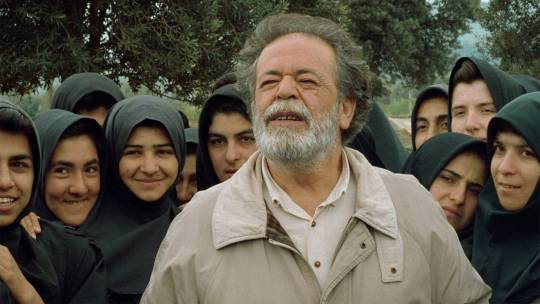

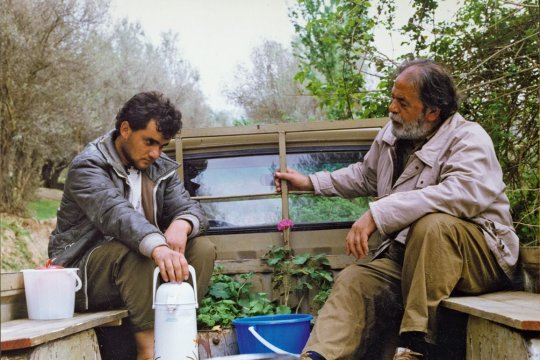


Through the Olive Trees (1994)
An Iranian director (Mohammad Ali Keshavarz) acts as go-between when his lead actors won't work together because of cultural differences. This Iranian movie about making movies wavers between a documentary and a fictional drama.
#Iran#Iranian#Iranian cinema#Through the Olive Trees#zire darakhtan zeyton#Mohammad Ali Keshavarz#Hossein Rezai#Tahereh Ladanian#Abbas Kiarostami#Kiarostami#film#Iranian film#films#filmmaking#movie#movie about making movies#fiction#documentary#fiction film#documentary film#drama#drama film#cinema#films to watch#must see films#underrated films#Arab world#Arabic cinema#Arabs#Arab film
125 notes
·
View notes
Text
10.27.19
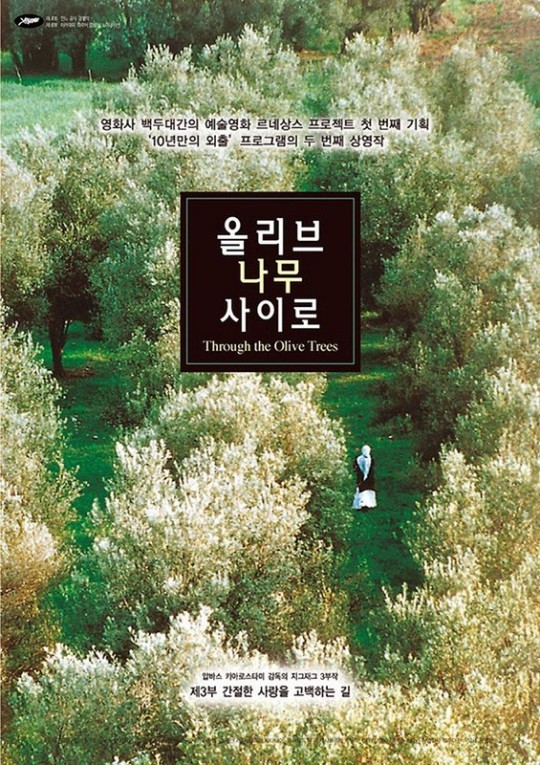
#film#watched#letterboxd#abbas kiarostami#through the olive trees#mohamad ali keshavarz#farhad kheradmand#zarifeh shiva#hossein rezai#tahereh ladanian#hocine redai#zahra nourou#nasret betri#azim aziz nia#astadouli babani#n. boursadiki
2 notes
·
View notes
Photo

112. Trilogia Koker: Através das Oliveiras (Zire darakhatan zeyton, 1994), dir. Abbas Kiarostami
#cinema#abbas kiarostami#hossein rezai#tahereh ladanian#Iranian cinema#1990s movies#classic movies#koker trilogy#drama#film crew#long shot#sequel#third part#filmmaking#earthquake#unrequited love#palme d'or nomination#world cinema#cult film#cult director#cinefilos
1 note
·
View note
Text
FILM FESTIVAL REVIEW; Blurring Truth and Fiction in Rural IranThrough the Olive Trees
By Stephen Holden
Sept. 24, 1994
In Abbas Kiarostami's film "Through the Olive Trees," Hossein Rezai, a nonprofessional actor with soulful eyes and a streak of stubbornness that is as big as his ego, plays a love-smitten bricklayer whose would-be fiancee (Tahereh Ladania) refuses to acknowledge his existence. Complicating matters is the fact that the two have been cast as newlyweds in a movie about earthquake survivors in northern Iran.
The film, which will be shown at Alice Tully Hall tomorrow evening at 6:45 P.M. as part of the New York Film Festival, is the story of one persistent man's pursuit of a woman who believes he is beneath her. It is also a richly textured quasi-documentary portrait of a rural Muslim society in which the people display a remarkable resilience in the face of catastrophe.
In "Through the Olive Trees," the Iranian director has some serious cinematic fun in the manner of Truffaut's "Day for Night." Because Mr. Rezai essentially plays himself, truth and fiction become thoroughly blurred. The film revels virtuosically in such Pirandellian paradoxes. Conceived as a fictional cinema-verite documentary about the making of another movie, the same director's "And Life Goes On," which was shown two years ago at the New York Film Festival, "Through the Olive Trees" is a cinematic Chinese box inside of the earlier film.
"And Life Goes On" is also a largely improvised quasi-documentary, shot in the same area only days after a major earthquake. Most of the players used in both films are nonprofessional local residents, many of whose lives were devastated by the quake.
Mr. Rezai was featured in one of that film's more memorable vignettes, playing a young man who describes going ahead with his wedding despite the destruction of his home and the loss of 65 relatives. He tells of living in a field with his wife in an improvised shelter. The filming of that scene is re-enacted in "Through the Olive Trees."
Adding an extra conceptual twist is the fact that Mr. Kiarostami does not portray himself in the new movie. Mohamad Ali Keshavarz, who portrays the director, is a shaggy-haired bear of a man who suggests an Iranian version of John Huston. The way all this theory plays out is much less complicated than it might seem.
Mr. Rezai emerges as an intriguing, if not entirely likable, character. Now that he's an actor, he announces, he will never do masonry again. But as he pursues the object of his affection, who refuses to speak to him or even to make eye contact, his ardent appeals become badgering. In the film's spectacular final scene, the camera follows him in a long shot as he trails behind his beloved on a course that takes them up and down a mountain slope and across a field until the two of them of almost disappear.
Like the earlier movie, "Through the Olive Trees" combines a panoramic visual beauty with an acute sense of human tininess in the face of eruptive natural forces.
THROUGH THE OLIVE TREES Produced, written, directed and edited by Abbas Kiarostami (in Farsi, with English subtitles); directors of photography, Hossein Djafarian and Farhad Saba; released by Miramax Films. At Alice Tully Hall tomorrow evening at 6:45 as part of the 32d New York Film Festival. Running time: 108 minutes. This film has no rating. WITH: Hossein Rezai (the man), Mohamad Ali Keshavarz (the director), Tahereh Ladania (the woman), Ahmad Ahmadpour (a brother), Babak Ahmadpour (a brother), Mahbanou Darabin (the grandmother), Farhad Kheradmand and Zarifeh Shiva.
#the new york times#abbas kiarostami#iran#cinema#through the olive trees#Hossein Rezai#and life goes on#mohamad ali keshavarz
0 notes
Text
Zum Schluss brüllt der Drachen
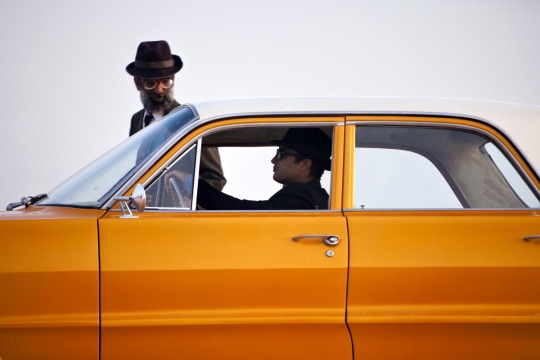
Der iranische Regisseur Mani Haghighi schließt mit »A Dragon Arrives« den Wettbewerb so fulminant ab, wie er zu keinem Zeitpunkt war. In überwältigenden Aufnahmen erzählt er eine kafkaeske Geschichte des Iran und öffnet für den Zuschauer den Raum der Assoziation.
Vor Jahren stieß Mani Haghighi auf die Geschichte einer verschlossenen Kiste, in der sich Tonbänder von Geheimdienstverhören aus den sechziger Jahren befunden haben sollen. Innden Aufnahmen geht es um die Geschehnisse auf der iranischen Insel Qeshm, wo der Ermittler Babak Hafizi den angeblichen Selbstmord eines verbannten politischen Gefangenen untersuchen soll, der inmitten der inseleigenen Wüstenlandschaft in einem alten Schiffswrack erhängt aufgefunden wurde. Die Wände des Wracks sind über und über beschrieben mit Romanzitaten, Gebeten, Tagebuchaufzeichnungen, deren Bedeutung rätselhaft bleibt. Er beschließt, in der Schiffshöhle zu übernachten. In der Nacht kommt es zu einem Erdbeben, nichts ungewöhnliches für den Iran, wenn er nicht von dem Dorfältesten vor einem Aufreißen der Erde gewarnt worden wäre, als er den Toten auf dem alten Friedhof vor der Schiffsruine verscharren ließ. Dass er in derbnacht auch noch leise Stimmen gehört hat, nährt nur Hafizis Unruhe. Wenn er wüsste, dass er in einigen Wochen mit einem Geologen und einem Audiologen in den Verließen des iranischen Geheimdienstes unter dem Schah verhört und mit dem Tod bedroht wird, wäre seine Unruhe wohl noch viel größer.
So aber reist er mit den beiden Wissenschaftlern erneut in die Region, um die seltsamen Phänome zu untersuchen. Dabei kommt es zu einigen seltsamen Ereignissen. Die verschollene Tochter des Dorfheilers bringt in einem versteckten Kellerraum unter dem Schiff ein Kind zur Welt und stirbt im Moment der Geburt. Bei Probegrabungen wird ein Mann von der Erde verschluckt und berichtet nach seiner Rettung von einem schuppigen Wesen mit feurigen Augen. Und nachts hallen durch Wüste markerschütternde Schreie.
So magisch und kafkaesk das alles klingt (eines der Vorbilder von Haghighi ist der chilenische Schriftsteller Roberto Bolaño), so sehr sucht man nach der Bedeutung all dieser Zeichen und Wunder. Man hofft sie, in den Jahreszahlen und politischen Andeutungen zu entdecken, verliert sich aber allzu schnell in den Tiefen der eigenen Wissenslücken. Der iranische Regisseur Mani Haghighi will den Film als »enigmatisches Objekt« verstanden wissen, der viele Geheimnisse in sich trägt, denen die Zuschauer auf den Grund gehen sollen. »Der Film bedeutet etwas, aber es ist schwer, herauszufinden, was genau er bedeutet. Das muss jeder für sich selbst beantworten«, sagte er gegenüber der Presse.

Ejhdeha Vared Mishavad! | A Dragon Arrives! | © Abbas Kosari
Ihm ist übrigens das Publikum am liebsten, das am wenigsten Wissen über die iranische Kultur und Geschichte mitbringt, denn dieses Publikum sei viel offener für die »dialektische Spannung« zwischen Wahrheit und Fiktion, derer er sich bedient. Verstärkt wird diese noch durch den Hinweis zu Beginn des Films, er basiere auf wahren Ereignissen, sowie durch dokumentarische Ausnahmen zur Entstehung des Films. Allerdings wird mit jede Minute des Films immer unwahrscheinlicher, dass sich diese Geschichte tatsächlich zugetragen hat, denn immer mehr unerklärliche Phänomene beeinflussen Haghighis Erzählung.
Der Iraner ist kein unbekannter auf der Berlinale, 2006 präsentierte er sein zweites Werk Men at Work, 2012 seinen vierten Film Modest Reception. Mit A Dragon Arrives vollzieht er nun den Sprung aus dem Forum in den Wettbewerb. Und er springt weit, verdammt weit. Erzählerisch spielt er mit der Angst vor staatlicher Gewalt, die nicht nur in Irans Geschichte verankert ist, sondern auch tief in der modernen Gesellschaft steckt. Sein fulminanter Film ist ein magischer Mash-Up aus orientalischen Mythen, politischem Thriller und popkulturellen Elementen, die von der perfekten Vintage-Kostümierung bis zum kongenialen Music Design (von Christophe Rezai) reicht.
Vor allem aber ist A Dragon Arrives sensationell in seiner Visualität, die diesjährige Berlinale hat in dieser Hinsicht nicht annähernd etwas Vergleichbares zu bieten. Dies liegt zum einen am spektakulären Szenenbild (von Amir Hossein Ghodsi), dass in einer weithin ikonografisch festgefahrenen Landschaft eine neue Welt schafft. Zwar ist das Wüstenschiff eine gesetzte Metapher, hier erhält es in seiner mythischen Aufladung im Interieur und vor einer überwältigenden Naturlandschaft einen neuen Sinn. In diesen ohnehin schon gigantischen Rahmen setzt er mit knalligen Farben und geilen Autos visuelle Akzente, die er in perfekten Panoramen so wunderbar in Szene setzt, dass man sich jede dieser glänzenden Aufnahmen als Einzelbilder an die Wand hängen möchte.
Read the full article
0 notes
Text
AND LIFE GOES ON:
Director and son
Drives to village he filmed in
Destroyed by earthquake
youtube
#and life goes on#random richards#poem#haiku#poetry#haiku poem#poets on tumblr#haiku poetry#haiku form#haiku on tumblr#criterion collection#abbas kiarostami#life and nothing more#Zendegi va digar hich#Farhad Kheradmand#Buba bayour#Hossein Rezai#Hocine Rifahi#Youtube
1 note
·
View note
Text
Evaluation of the effects of climate change on meteorological and hydrological parameters using climatic models and Mann – Kendall test (case study: Urmia Lake) – JBES
See on Scoop.it - IJAAR-INNSPUB
Somayeh Mahmoodi Khaneshan, Zabihollah Khani Temeliyeh, Hossein Rezaie Graduated Master of Water Resources Engineering, Urmia University, Urmia, Iran Graduated Master of Water Resources Engineering, Urmia University, Urmia, Iran students (Candidate) in Water Resources Engineering, Urmia University, Urmia, Iran Key words: Climate change, Urmia, Mann-Kendall, ANN, SDSM. Abstract Climate change and increase of global temperature are…
1 note
·
View note
Text
President’s Design Award: Engineer among three Star of the Year winners
SINGAPORE: For the first time because the President’s Design Award was started in 2006, an engineer, Dr Hossein Rezai, was one of the three winners of this prestigious Designer of the Year honor.
The awards have been passed out by President Tony Tan Keng Yam on Friday (Dec 9) at a ceremony at the Istana, DesignSingapore Council and the Urban Redevelopment Authority stated in a joint statement.
Dr Rezai, director of Web Structures and also a chartered engineer in structural and civil engineering, has also been engaged in the design and realisation of jobs like Assyafaah Mosque, that employs a reinforced concrete masonry framework to create a column-free prayer hall on the floor level and to encourage three storeys of classrooms as well as other ancillary spaces.
(Photo: Web design)
The arched framework helped to free up more space on the floor, as well as lower construction costs by 6.5 percent. The complete cost of building the building was US$43 million.
Dr Rezai told Channel NewsAsia that good design and cost efficiency were not mutually exclusive. “With our structural layouts we believe there’s no reason why people ought to use any more material than is absolutely necessary. You won’t gain anything by spending more or using more material once it has to do with construction. Therefore, we minimise the carbon footprint of our construction by utilizing the usage of material.”
The engineer’s other projects in Singapore include Mediacorp’s brand new 12-storey, 800,000sqft campus at Stars Avenue as well as Tokio Marine Centre and the Ardmore Residence.
(Photo: Web design)
Along with Dr Rezai the Designer of the Year award was also awarded to architects Rene Tan and Raymond Woo.
Cited among the most recognized and well-respected characters from Singapore’s architectural industry, Mr Woo was supporting Singapore landmarks like the aged Science Centre in Addition to Ngee Ann City around Orchard Road.
(Clockwise, from top) Singapore Science Centre, B747 Hangar and Ngee Ann City. (Photos: RWAA & Max Ooi)
10 jobs won the Style of the Year award. They include three architectural jobs, as well a medical device to extract blood safely, easily and with minimal pain; a ultrasound scanner made to assess pregnancy dangers early; as well as a washing machine that lets users add things mid-cycle.
A record amount of 140 nominations were received this past year. An exhibition of this President’s Design Award 2016 will be kept at the National Design Centre in Dec 10 to Jan 6, 2017 and at the URA Centre by Jan 9 to 27, 2017. Admission is absolutely free.
Raymond Woo & Associates Architects
Layout of the Year
Bynd Artisan
Wong Mun Summ & Richard Hassell and Team
HP OfficeJet Pro 8720 All-in-One Printer
HP Inc..
Samsung Electronics Pte Ltd
Wong Mun Summ & Richard Hassell and Team
Chemistry Type Pte Ltd & GE Healthcare
Bassam Jabry, Karin Aue & Abhay Nihalani and Team
Wah Son @ Seletar Aerospace
from artingerdesigns http://www.artingerdesigns.com/presidents-design-award-engineer-among-three-star-of-the-year-winners/
0 notes
Photo
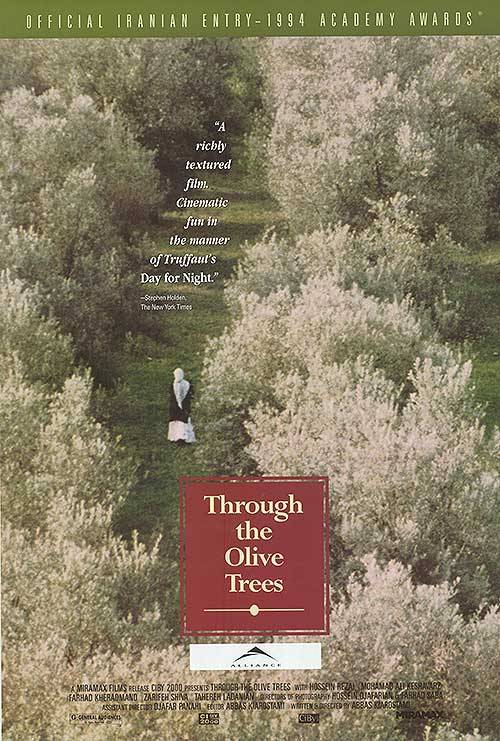









Under Olivträden (1994)
Under Olivträden (1994) är den sista av de tre filmer som ingår i Abbas Kiarostamis Koker-trilogi om kärlek, passion och livet självt.
I denna får vi fortsätta att fördjupa oss i historien kring regissörens jakt efter huvudrollsinnehavaren i filmen Khane-ye doust kodjast? (1987), men här har Kiarostami valt att återgestalta en del av tiden kring inspelningen av film nummer två, Zendegi va digar hich (1992), eller And life goes on, som den heter på engelska. I en scen i filmen And life goes on träffar huvudkaraktären, regissören, en man som berättar att han nyligen gift sig. Som jag förstår det så hände detta alltså på riktigt och Kiarostami väljer att återskapa detta i filmen, med skådespelare. Den man, som verkar heta Hossein Rezai, som spelar denna roll ska ha blivit förtjust i den kvinnliga skådespelerska som spelar hans nyblivna fru i samma scen, i filmen And life goes on. Detta, just detta blev Kiarostami fascinerad av, och denna förälskelse väljer han alltså att forma sin tredje film kring, där Hossein Rezai återigen syns i bild, men här spelar han snarare någon slags semi-verklig version av sig själv, där man får följa med honom “bakom kulisserna” till filmen And life goes on.
Hänger du med? Mark Cousins försöker att förklara det här i ett utdrag från hans tv-dokumentär The Story of Film: An Odyssey. Jag har även redan försökt att återberättat detta i min text om Khane-ye doust kodjast?.
Helt fräckt har Kiarostami också låtit just den lille pojken Babek Ahmed Poors från första filmen som nu är tonåring, okommenterat dyka upp för att spela en liten roll som springpojke i denna sista film. Han hittade alltså pojken tillslut, och där står han nu, sida vid sida med sin barndomsvän från Koker (se bild 6) som han sju år tidigare försökte ta sig hela vägen hem till för att överlämna vännens skolbok.
Även denna film är en vacker skildring av mänsklig samvaro och livsglöd (hur ospecifikt och vagt det än låter) och jag slås återigen av hur en tillsynes så “enkel” film med så avskalat filmspråk kan beröra så mycket. För det är verkligen någonting alldeles unikt med Kiarostamis filmer som berör lite mer än de flesta andra.
#through the olive trees#under olivträden#Zire darakhatan zeyton#1994#1990s#Abbas Kiarostami#iransk film#Koker trilogy
0 notes
Photo


Through the Olive Trees, 1994
#through the olive trees#abbas kiarostami#hossein rezai#iranian films#iranian cinema#tahereh ladainian
912 notes
·
View notes
Photo









881. زیر درختان زیتون / Zīr-e Derakhtān-e Zeytūn (1994)
Abbas Kiarostami, the Iranian director responsible for Close Up -822-, presents another peculiar film here. It is a kind of "making of" of an earlier film of his, which in turn took back some of the characters and performers of an even older flick. Not having seen any of the two previous movies, it's been a strange experience for me.
The protagonist seems to be Hossein Rezai one of the actors in the film who is in love with his cast partner. The girl, reluctant to compromise, has to suffer the advances of the boy in front and behind the cameras. An action that in any other work environment would be considered harassment but which within film industry is considered as utterly romantic.
Honestly, I just do not understand the interest of this film. If it is to show the complications of filming, it loses all its force by using a fictional frame but with the actors talking straight to the camera about the characters they represent. On the other hand, if the purpose is to show a love story within the traditional Iranian context, the story just scratches the surface.
However, there are some interesting points like the endless repetition of a scene or the difficulties of the production manager to find actors for the leading role. Small trifles that let us take a look at the backstage of the world of cinema.
Unfortunately, those rare moments hardly justify the viewing of this picture or make us forget superior works like the exceptional La Nuit Americaine -567- by François Truffaut.
28th July 2017
0 notes